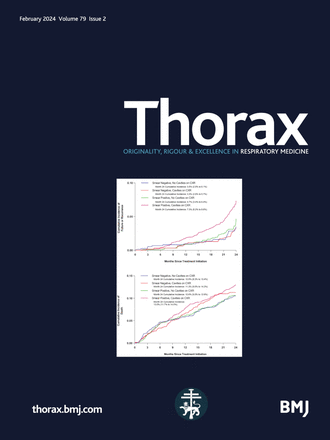Assessing causal relationships between diabetes mellitus and idiopathic pulmonary fibrosis: a Mendelian randomisation study
IF 7.7
1区 医学
Q1 RESPIRATORY SYSTEM
引用次数: 0
Abstract
Background Idiopathic pulmonary fibrosis (IPF) is a disease of progressive lung scarring. There is a known association between diabetes mellitus (DM) and IPF, but it is unclear whether a causal relationship exists between these traits. Objectives The objectives of this study are to examine causal relationships among DM, diabetes-associated traits and IPF using a Mendelian randomisation approach. Methods Two-sample MR approaches, including bidirectional inverse-variance weighted random effects and routine sensitivity models, used genetic variants identified from genome-wide association studies for type 1 diabetes (T1D), type 2 diabetes (T2D), glycated haemoglobin level (HbA1c), fasting insulin level and body mass index (BMI) to assess for causal effects of these traits on IPF. Further analyses using pleiotropy-robust and multivariable MR (MVMR) methods were additionally performed to account for trait complexity. Results Results did not suggest that either T1D (OR=1.00, 95% CI 0.93 to 1.07, p=0.90) or T2D (1.02, 0.93 to 1.11, p=0.69) are in the causal pathway of IPF. No effects were suggested of HbA1c (1.19, 0.63 to 2.22, p=0.59) or fasting insulin level (0.60, 0.31 to 1.15, p=0.12) on IPF, but potential effects of BMI on IPF were indicated (1.44, 1.12 to 1.85, p=4.00×10−3). Results were consistent in MVMR, although no independent effects of T2D (0.91, 0.68 to 1.21, p=0.51) or BMI (1.01, 0.94 to 1.09, p=0.82) on IPF were observed when modelled together. Conclusions This study suggests that DM and IPF are unlikely to be causally linked. This comorbid relationship may instead be driven by shared risk factors or treatment effects. Data are available upon reasonable request. Summary results for the GWAS of IPF susceptibility were requested through the collaborative genetic studies of idiopathic pulmonary fibrosis GitHub page: (评估糖尿病和特发性肺纤维化之间的因果关系:一项孟德尔随机研究
特发性肺纤维化(IPF)是一种进行性肺瘢痕形成的疾病。糖尿病(DM)和IPF之间存在已知的关联,但这些特征之间是否存在因果关系尚不清楚。本研究的目的是使用孟德尔随机化方法检查糖尿病、糖尿病相关特征和IPF之间的因果关系。方法双样本MR方法,包括双向反向方差加权随机效应和常规敏感性模型,使用从1型糖尿病(T1D)、2型糖尿病(T2D)、糖化血红蛋白水平(HbA1c)、空腹胰岛素水平和体重指数(BMI)全基因组关联研究中鉴定的遗传变异,评估这些性状对IPF的因果影响。使用多效性鲁棒性和多变量MR (MVMR)方法进行进一步分析,以解释性状复杂性。结果T1D (OR=1.00, 95% CI 0.93 ~ 1.07, p=0.90)和T2D (1.02, 0.93 ~ 1.11, p=0.69)不属于IPF的因果通路。HbA1c (1.19, 0.63 ~ 2.22, p=0.59)或空腹胰岛素水平(0.60,0.31 ~ 1.15,p=0.12)对IPF没有影响,但BMI对IPF有潜在影响(1.44,1.12 ~ 1.85,p=4.00×10−3)。MVMR的结果是一致的,尽管在一起建模时没有观察到T2D(0.91, 0.68至1.21,p=0.51)或BMI(1.01, 0.94至1.09,p=0.82)对IPF的独立影响。结论:本研究提示糖尿病和IPF不太可能存在因果关系。这种共病关系可能是由共同的风险因素或治疗效果驱动的。如有合理要求,可提供资料。IPF易感性GWAS的总结结果通过特发性肺纤维化GitHub页面的协同遗传研究获得:()。所有其他GWAS研究的汇总数据均从GWAS目录()中检索。
本文章由计算机程序翻译,如有差异,请以英文原文为准。
求助全文
约1分钟内获得全文
求助全文
来源期刊

Thorax
医学-呼吸系统
CiteScore
16.10
自引率
2.00%
发文量
197
审稿时长
1 months
期刊介绍:
Thorax stands as one of the premier respiratory medicine journals globally, featuring clinical and experimental research articles spanning respiratory medicine, pediatrics, immunology, pharmacology, pathology, and surgery. The journal's mission is to publish noteworthy advancements in scientific understanding that are poised to influence clinical practice significantly. This encompasses articles delving into basic and translational mechanisms applicable to clinical material, covering areas such as cell and molecular biology, genetics, epidemiology, and immunology.
 求助内容:
求助内容: 应助结果提醒方式:
应助结果提醒方式:


